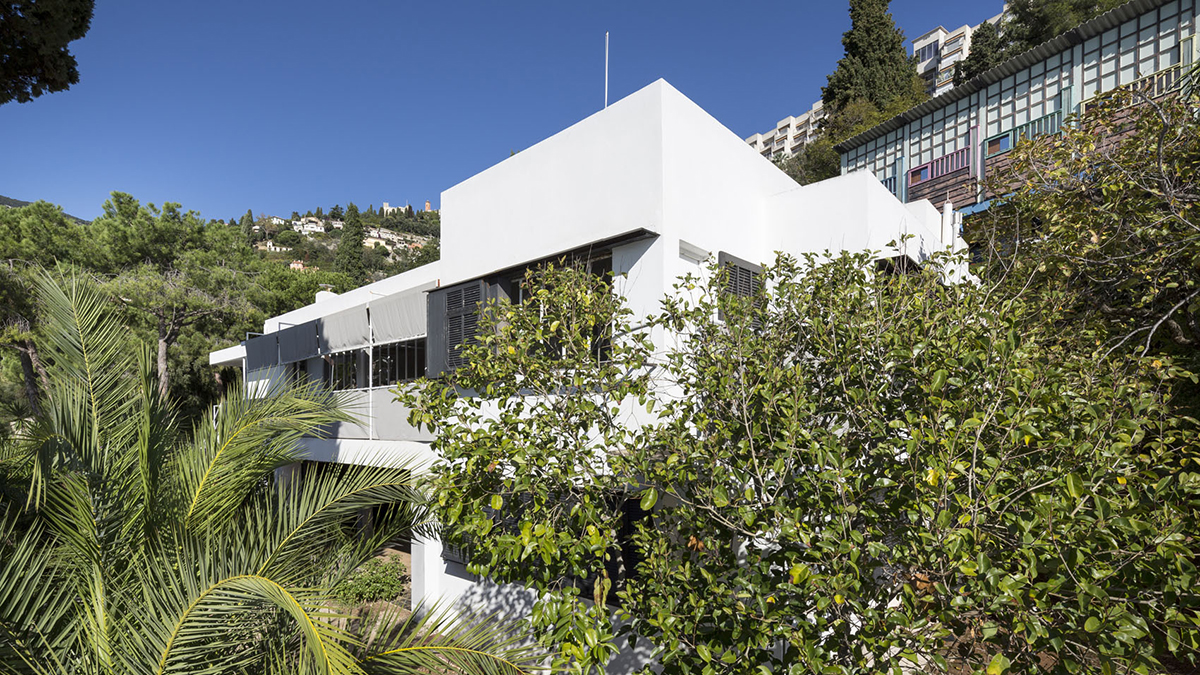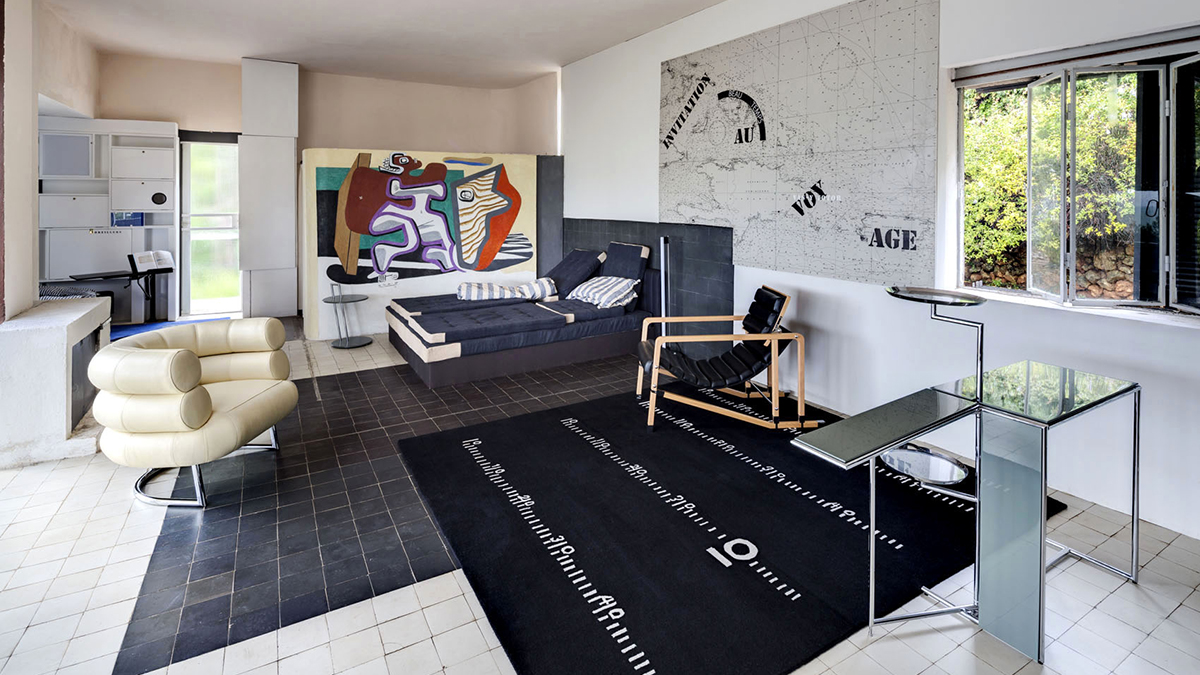Architect Sally Mackereth on Eileen Gray’s E1027 villa
A pioneer of Modernist design, Eileen Gray is a continuing influence on Sally Mackereth, who visits a modest but seminal masterpiece

A heady aroma of pine, ripe fig and sea salt greets us. We’ve made our way down an awkward, dusty footpath that follows the coastal railway tracks, then, quite unannounced, it comes into view: a horizontal white house perched elegantly and uncompromisingly on skinny white stilts rising up from the cliff face that sizzles under a stubborn Mediterranean sun. Its modernity is striking, its crisp white lines resolute and stark against the rugged darkness of the rock. Thrillingly cantilevered terraces stretch out towards the azure waters of the bay below.
I’m in Roquebrune-Cap-Martin in the south of France, making a pilgrimage to see one of the most iconic houses of the Modern movement, a holiday home designed by an unsung hero of the 20th century: Eileen Gray’s E1027. This modest building has recently undergone a programme of restoration after years of neglect, the French government having finally recognised it as a historical site where important proponents of the early 20th-century avant-garde scene hid away to relax, contemplate and create.
The significance of this small villa was largely ignored for decades, perhaps because its designer was not French but Irish-born, but most likely because she was a woman. Its story was also partly eclipsed by Le Corbusier’s later presence here – the wooden shack he built nearby looms behind it. ‘I have a castle on the Riviera,’ he used to say. ‘It measures 3.66 by 3.66 metres.’
The Week
Escape your echo chamber. Get the facts behind the news, plus analysis from multiple perspectives.

Sign up for The Week's Free Newsletters
From our morning news briefing to a weekly Good News Newsletter, get the best of The Week delivered directly to your inbox.
From our morning news briefing to a weekly Good News Newsletter, get the best of The Week delivered directly to your inbox.
E1027 has held a great fascination for me from the moment I began my studies as a young architect at the Architectural Association in London back in the early 1990s, and to be allowed to explore it in three dimensions is a rare treat. I’m also curious to find out whether this humble structure still holds any relevance for me almost 100 years after its inception.

At the beginning of the 20th century, Eileen Gray left behind her Anglo-Irish bourgeois beginnings and headed to Paris, where she was heavily influenced by the ideas and visions of poets, writers and artists she met. She soon became a leading figure in the decorative arts of the 1920s, creating stylish lacquered furniture and rugs that exhibited her signature combination of comfort, elegance and wit.
Together with her architect lover, Jean Badovici, Gray embarked on a new journey in 1927, when they purchased an isolated steep plot of inaccessible land with a small lemon grove on an outcrop of rock overlooking the sea, close to the French border with Italy. With technical assistance from Badovici, she spent three years rigorously designing and stubbornly overseeing the construction of the house she called E1027 (a code incorporating their intertwined initials). Completed when she was 49, her first building was a sublime debut. It would fundamentally question and challenge the intellectual ideas of the time in the search for an everyday poetry and elegance that would give expression to a new way of living.
Gray became swept up by the ideas of Modernism and the intoxication of the Machine Age, yet she also rallied against its cold mechanistic forms and over-intellectualised ideals. She questioned her friend Le Corbusier’s definition of the house as a ‘machine for living’, where architecture would return to the elementary – a vision of purity that stripped away all decoration and ornament to the extent that it dehumanised the occupant. In short, she rejected an architecture made up of fashionable formulas, arguing that the mathematical was being celebrated at the expense of the emotional. In E1027, she explored the ideas of a home that could be a genuine place to rest, to dream, to share and to be at peace with oneself.
A free daily email with the biggest news stories of the day – and the best features from TheWeek.com
Eschewing the limelight, Gray was fundamentally at odds with her peer group, who delighted in their quest for a radically expressive new exterior architectural form. It was as if ‘a house should be conceived for the pleasure of the eyes rather than the well-being of its inhabitants,’ she stated. It was her firm belief that ‘the interior plan should not be the accidental consequence of the facade; it should live its complex life, harmonious and logical. Far from being subordinate to the exterior shape, it should, on the contrary, determine it.’ This mantra for human sensibility has stayed with me throughout my professional life and it is an ideal I hold true and consider the hallmark of my own architectural projects.
Like Gray, I don’t believe in a one-size-fits-all approach or in look-at-me fashionable design for its own sake. Nor do I think the interior is a natural ‘female’ domain to be regarded as secondary to the ‘real’ architecture – though, regrettably, this misconception persists even today. While I like to create order and calm in the houses my studio designs, I don’t subscribe to soulless purity in architecture. I believe careful attention to the way we can experience light, colour, texture and materials plays a hugely important part in the emotional sense of place, something with which we as individuals connect.
Like E1027, where the entrance is nearly invisible, I have designed a number of houses with secret doors and unexpected views. Rather than statement ‘starchitecture’, I like my buildings to surprise and delight those who cross the threshold. While the preserved villa is pretty minimal, it is nevertheless perfectly comfortable, even by today’s standards, as it is extraordinarily well considered in its atmosphere. Its streamlined monochromatic planes define the living areas from the private spaces and are overlaid with a restricted palette of colours from nature – green, blue, brown and grey – to articulate the interior fitted elements. Gray’s bespoke furniture, and clever details such as the prototype glass folding doors or the freestanding screens that delineate private space within a larger space, are not simply functional but also joyful.
As I stand on the terrace of this modest house, with the vulgar high-rise apartments of Monaco in the distance to the west and the superyachts traversing the bay below in this ostentatious playground for the world’s wealthiest, I wonder how far have we moved on since 1929 in our quest to create the perfect home in which to live a good life?
-
 What will happen in 2026? Predictions and events
What will happen in 2026? Predictions and eventsIn Depth The new year could bring peace in Ukraine or war in Venezuela, as Donald Trump prepares to host a highly politicised World Cup and Nasa returns to the Moon
-
 Why is Trump’s alleged strike on Venezuela shrouded in so much secrecy?
Why is Trump’s alleged strike on Venezuela shrouded in so much secrecy?TODAY'S BIG QUESTION Trump’s comments have raised more questions than answers about what his administration is doing in the Southern Hemisphere
-
 Vance’s ‘next move will reveal whether the conservative movement can move past Trump’
Vance’s ‘next move will reveal whether the conservative movement can move past Trump’Instant Opinion Opinion, comment and editorials of the day